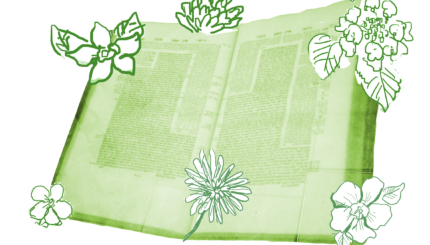Reprinted with permission from American Jewish Fiction: A JPS Guide (Jewish Publication Society).
By the second page of Nathan Mayer’s novel Differences, the reader has learned that Louis Welland hails from Germany and that he has, therefore, a poetic and slightly foolish temperament. A couple of pages later, the narrator enumerates Welland’s physical characteristics, which include “the chest of a Hercules” as well as “that elegance of appearance, which results from perfect symmetry of form”–in other words, he’s a looker.
Coyly, though, Mayer withholds until page 48 the fact that Welland–respectful, honest, courageous–also happens to be Jewish, and, when he reveals his faith to the Goldmans, a family of his coreligionists in northeastern Tennessee, they respond with “a pause of astonishment,” as if to say: You? Really? You’re Jewish?
 Jewish and American…a Novel Concept
Jewish and American…a Novel Concept
Welland soon tumbles into love with Antonia, the Goldmans’ beautiful and literary-minded daughter (she’s a fan of Goethe and George Sand), but, in the fashion of traditional romances (not to mention contemporary romantic comedies), circumstances conspire to keep the lovers apart.
As the tensions of the 1860s mount, local rabble accuse Welland of abolitionism and then chase him out of Tennessee. After his arrival in New York, miscommunications and the jealousy of Antonia’s brother Charles convince Antonia that Welland is two-timing her. Soon the Civil War breaks out, and Welland fights on the side of Union, while Antonia, a loyal Southern belle, cheers on the Confederate troops. Thanks to Welland’s unflinching gentlemanliness, though, all of the issues are eventually resolved, and the book ends with the coming together not only of the Union and Confederacy but also of Jews and non-Jews. The book’s closing lines (“United in love … notwithstanding former differences … United forever”) speak to the hope of healing concord ardently desired not only in postbellum America but also by generation after generation of American Jews.
The Differences of American Jews
Mayer’s book, a fascinating document of its times, has been called the first American Jewish novel of significant literary interest. In addition to presenting period detail, ranging from kosher recipes to the reading habits of the upper classes in the 1860s to elaborate battle scenes, the novel deliberately refutes the prevalent stereotypes of the 19th century of Jewish men as degenerates, sissies, or cutthroat mercantilists.
Such Jews do appear in Differences: the unsubtly named Mr. Sellington Sharp, the Goldmans’ shochet and associate, and later a faithful go-between for Welland and Antonia, is described as having a “hook nose” and “a good deal of cunning and vulgarity”; he also finds firearms terrifying. A young New York associate of Charles Goldman, meanwhile, is so allured by wealth that he refers to his potential dates by the names and products of their father’s companies (“Don’t you know her? Krakowwitzer & Co, Gents’ Clothing and Furnishing Goods”).
WeIland, in contrast, demonstrates that Jewish masculinity can be everything and more than its non-Jewish counterpart–while the novel, with its approving commentary on intermarriage (as long as the non-Jewish partner converts!) and on the vigorousJewish participation in the nation’s bloodiest and most consequential war, suggests Mayer’s hopefulness about the future of Jews in the United States.
Further reading
Very little information on Mayer has survived; even academics haven’t devoted much attention to him. He mayor may not have modeled the surgeon who makes a cameo in Differences on himself. An entry in the Norton Anthology of Jewish American Literature offers a few details about Mayer’s life, as well as an excerpt from another one of his novels, a historical romance called The Fatal Secret (1858). Those interested in the history of the period can consult Bertram W. Korri’s American Jewry and the Civil War (1951) or the edited letters of a real-life Jewish Civil War colonel published under the title Your True Marcus (1985). A much more recent historical novel, Peter Melman’s Landsman (2007), features the wartime experiences of a Jew from New Orleans, and if you have a high tolerance for sentimentality, also seek out Belva Plain’s Crescent City (1984).
kosher
Pronounced: KOH-sher, Origin: Hebrew, adhering to kashrut, the traditional Jewish dietary laws.


